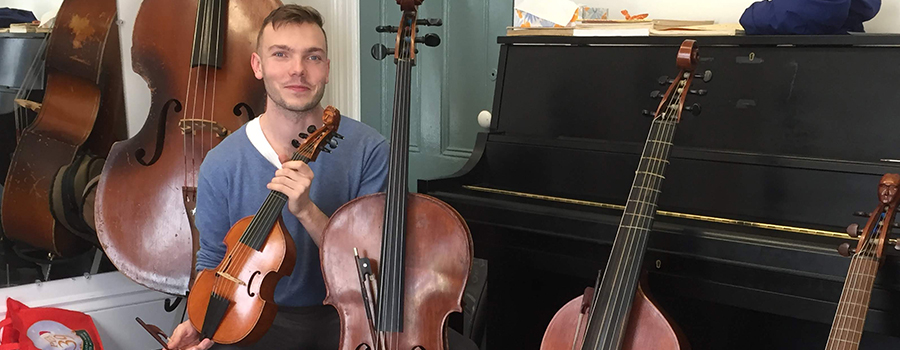“It’s easier than you think. You’re connected to a larger community through your class. You won’t be doing it alone.”
Erik Andersen, CMC faculty member (cello, Cello Ensemble and Technique, Introduction to Viola da Gamba, YMP, MDB Chamber Music Camp Director)
Group classes and ensembles at CMC can be the next important step in honing hard-won skills developed through private lesson study. Group classes and ensembles are unique learning environments where students from diverse musical backgrounds play music together. They are musical communities of mutual support and encouragement.
CMC faculty member Erik Andersen teaches the Cello Ensemble and Technique and Introduction to Viola da Gamba group classes, both of which cater to beginning music students. He is the Mission Branch Chamber Music Camp Director and is part of the faculty for the Young Musicians Program. He also teaches private cello lessons. Since Erik teaches all ages and all levels of private lessons, group classes, and ensembles, he has valuable perspectives on the benefits of group learning.
Group classes as stepping stones
From Erik’s perspective, private lessons, group classes, and ensemble-playing complement one another, inherently reinforcing and utilizing many of the same skills. However, the group class experience has the added benefit of group learning through playing music together. Trying something new and difficult for the first time as a group, can take some of the pain out of the learning process. Playing in a group class can also teach important skills a student will need when they’re ready to try an ensemble, like blending and framing the overall sound with your playing. A group music class can be a crucial stepping stone between private lesson study and a larger ensemble. Playing in a music ensemble, a student can learn other unique skills like supporting the larger sound while being the only instrument of your type (in the case of a cellist in a chamber group) or following a conductor (in the case of a larger ensemble like the String Orchestra Workshop). The inherent vulnerability of putting yourself out there that exists in ensemble playing, is an exciting and rewarding experience for music students.
Erik’s student Susie Zacharias shared her first-hand perspectives transitioning from the group class experience to the large ensemble String Orchestra Workshop, “In Erik’s group cello class, I am learning different cello techniques that profit from practicing in a group. I consider it a very efficient way of learning new things on the cello. For the string orchestra (since I’ve only been playing three years) it’s like being thrown into the deep end of the pool and you just swim. For me it’s invaluable also in a different way from the group class—you gotta keep going! Don’t overly worry what it sounds like. And since I want to play ensemble, this is what I need. It’s so much fun.”
The musical community of a group class
From Erik’s point of view, a group class that caters to beginners or beginners with some basic skills, is a fun environment of mutual support and learning. Especially at CMC, a music student can expect to be in a group class with students from all musical backgrounds and training. For Erik, this diverse learning environment is wonderful. He enjoys witnessing his students encouraging and supporting one another. As Erik says, “The group class can be unique. Where else can you get support and sympathy from your peers, who are also trying to learn the same challenging skills as you are?”
Erik’s student Greg King shared his personal experiences about the benefits of playing in a group class,“I have found the teachers at CMC inspiring whether private lessons on the cello with Erik or theory classes with Jono Kornfeld. They both make learning music a joy. The added benefit are the other students in my group classes. Each of us comes from either different instruments or musical interests, and that adds to the experience.”
For people interested in learning an instrument from scratch, such as the Baroque viola da gamba in Erik’s class Introduction to Viola da Gamba, he is encouraging, “It’s easier than you think. You’re connected to a larger community through your class. You won’t be doing it alone.”
Registration for Fall Quarter classes opens August 5. To make an appointment to register, visit www.sfcmc.org/enrollment, or enroll online where available.



